Lake Powell, Arizona
Round and round.
We passed the mouth of Antelope Canyon, a narrow cut that goes a considerable distance back into the Navajo Nation. Far enough to support a thriving industry of tour guides. Antelope is famous for its high walls, "narrow, eerie slots", and for a flash flood that took 11 lives back in 1997.
My neighbor back on Jemez Creek above Albuquerque had told me about getting caught in something like that, out here somewhere. He and his wife were puttering around in a small canyon, getting ready to fish, when suddenly the wind whipped up and came roaring down the slot, and water with it. He had about half a minute to decide whether to abandon the boat and climb, or run for it. He turned and ran. Thank God the motor didn't stutter, and they didn't meet a tour boat coming in. That wall of water partly caught and pushed them, but gradually the force was spent as the channel turned and widened and turned, and then they were out in the main channel.
The odd thing, he said, was that looking back you couldn't tell anything had happened. Just dark clouds overhead, and a strong breeze.
Much like today. A typical heartbreaker of a day, if you happen to be a Navajo farmer. All clouds and no rain. Every now and then I think I feel a drop, but it's just spray from the keel cutting the water.
That stops as we turn a corner and troll slowly past Antelope Marina. Everything is being expanded here, perhaps doubled in size. They are going to have slips for over 300 houseboats. Some monsters are already in place. Houseboats? HouseMansions, more likely. Megabucks stored away here, hidden in an ancient crook of the Colorado, calmly riding the lake level down as the drought goes on and on.
Some of these barges look like they'd have trouble negotiating this channel. They'd certainly want to try it one at a time. Back and fill, like a motorhome trying to get into a California Stopandshop for gas.
Back in the not-so-old days there was no place to cross the Colorado anywhere within 200 miles of here, but that didn't stop a party of Mormon settlers. They just blew up the side of a massive cliff to widen a crack, and used ropes to lower wagons and horses hundreds of feet down the canyon walls.
Give some guys a little gunpowder, they are apt to redefine the term "accessible".
| From there on it was just vista after vista, with miles and miles of side canyons coming into view. Out here in the middle it doesn't look like the lake is low. | 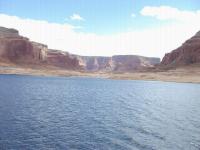 |
It wasn't quite as much fun as watching Mormons blow up stuff, but all we had to do from then on was just kick back and enjoy the ride down the middle of the main channel for an hour or so, until we reached the narrow canyon that led to the "world's largest natural rock span". Helpfully, the Park Service has placed a floating sign in front, so you can't miss it.
The predominant colors in here are rust and chalky white, with a fringe of green on ledges here and there. Apparently there's nothing alive out here larger than a crow, the frankenstein of squawking birds.
Apart from you and me, that is.
Round and round and round.
The Rainbow Bridge cannot be seen from the boat, this time of year. Or any time in the last four years. It's a mile and a quarter walk, along a dry creek where small brush is beginning to take hold where water ought to be. A floating dock is gradually pushed up and down the creek as needed. A Korean couple carried a pram with their toddler in it most of the way up, shedding clothes as they climbed.
The air grew rapidly warmer as we climbed.
As you might expect in a National Park, there's a "Don't climb on the Arch" sign. Something to that effect. Oh, and don't pass under it. The Navajos don't like that, or at least the old ones didn't. Since both acts are difficult, or at least require effort, for once I had no difficulty following the rules.
Back at the dock, the water was roiling with enormous carp and striped bass, which apparently have become addicted to the potato chips included in the box lunch that comes with the tour. Some of these fish were monsters. Charlotte said someone had caught a 48 pound striped bass up here.
These were about a quarter that size. If the bass get that big, then somewhere in this lake there is a carp large enough to eat your boat.
You have been warned. Dum-dum. Dum-dum. Dum-dum, Dum-Dum. Harry, did you hear that? Harry?
The trip back was relaxed, the same views seen anew from a different angle. The few flashes of sunlight we got on the way down had disappeared, and the dark clouds grew close, but still it didn't rain. Most of my photographs were spoiled by the darkness, and rendered slightly out of focus by the motion of the boat. I suppose there may have been some ineptitude involved. I've only had the camera 5 years or so. Someday I'll get around to reading the directions.
I stayed topside. It was a fine ride.
It's supposed to clear off a bit on Friday. I'm headed down to the North Rim of the Grand Canyon. I hope none of this wet stuff turned to snow. If not, the road should still be open. Then I have to return to Page to pick up my mail-in ballot. After that particular date with destiny, I'll have to decide whether to go up to Bullfrog Basin and rent a boat, or resume my trip south into the Hopi lands.
The weather will tell me where to go. How's that for a plan? It's about as organized as I get these days.
There it is again. That stupid grin. Sometimes I just can't get it off my face.
Bob

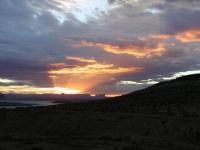
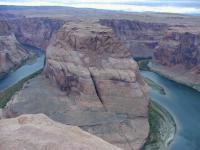
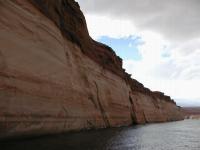
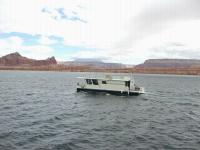
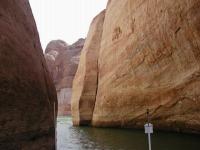
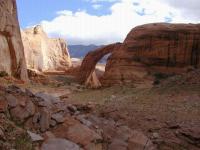
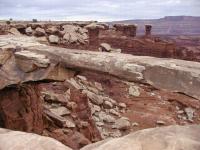
No comments:
Post a Comment